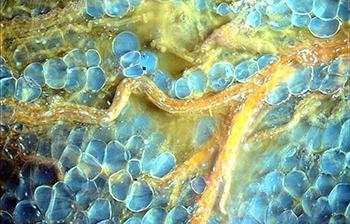
Credit: Richard Levenson, UC Davis
MUSE image of sebaceous glandA microscope using ultraviolet light to illuminate samples enables pathologists to assess high-resolution images of biopsies and other fresh tissue samples for disease within minutes, without requiring the time-consuming preparation of conventional slides or destroying the tissue.
This approach holds promise for improving the speed and efficiency of patient care and medical research nationwide, a study published today in the journal Nature Biomedical Engineering has found.
The technology, known as microscopy with UV surface excitation, or MUSE, uses ultraviolet light at wavelengths below the 300 nanometer range to penetrate the surface of tissue samples by only a few microns (about the same thickness of tissue slices on traditional microscope slides.) The phenomenon was originally described by Stavros Demos, one of the co-authors, who is now at the University of Rochester.
Samples that have been stained with eosin or other standard dyes to highlight important features such as nuclei, cytoplasm and extracellular components produce signals from the UV excitation that are bright enough to be detected by conventional color cameras using sub-second exposure times. The process allows for rapid imaging of large areas and immediate interpretation.
Richard Levenson with MUSE technology"MUSE eliminates any need for conventional tissue processing with formalin fixation, paraffin embedding or thin-sectioning," said Richard Levenson, professor and vice chair for strategic technologies in the Department of Pathology and Laboratory Medicine at UC Davis and senior author of the study.
"It doesn't require lasers, confocal, multiphoton or optical coherence tomography instrumentation, and the simple technology makes it well suited for deployment wherever biopsies are obtained and evaluated," he said.
MUSE's ability to quickly gather high-resolution images without consuming the tissue is an especially important feature.
"It has become increasingly important to submit relevant portion of often tiny tissue samples for DNA and other molecular functional tests," he said. "Making sure that the submitted material actually contains tumor in sufficient quantity is not always easy and sometimes just preparing conventional microscope slices can consume most of or even all of small specimens. MUSE is important because it quickly provides images from fresh tissue without exhausting the sample."
The ability to obtain instant, high-resolution, full-color images for histology, pathology or toxicology studies is also useful for basic scientists who want to assess tissue samples from experimental animal models at the laboratory bench. The technology is being commercialized by MUSE Microscopy Inc.
###
Media Contact
Carole Gan
[email protected]
916-734-9047
@UCDavisHealth
http://www.ucdmc.ucdavis.edu
Original Source
http://www.ucdmc.ucdavis.edu/publish/news/newsroom/12507 http://dx.doi.org/10.1038/s41551-017-0165-y





